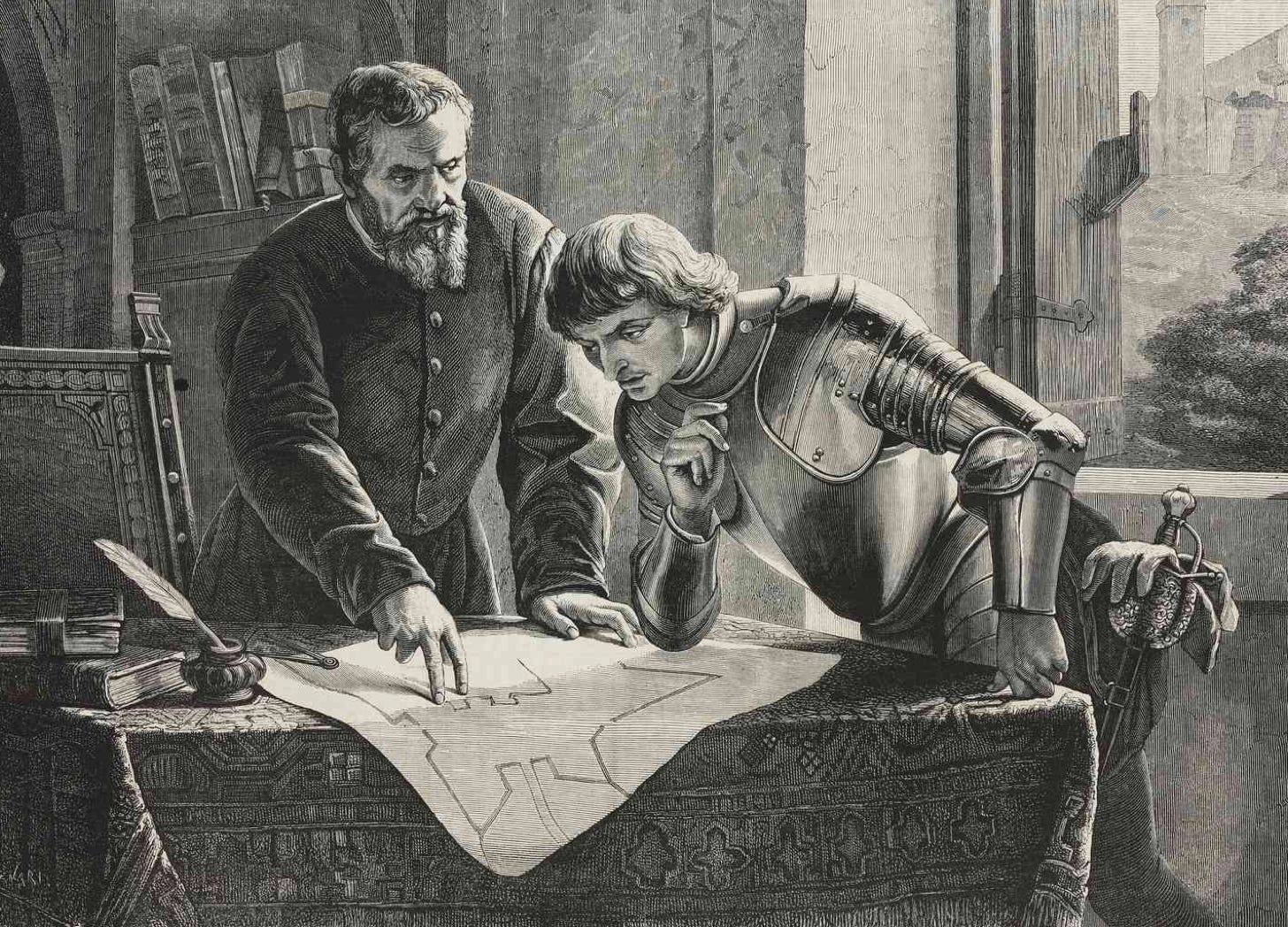A Different Kind of War Game
The Walls of Florence

“Maestro Buonarroti, please accept my congratulations. The government of our beloved Republic of Florence has named you Director of Fortifications. You know well our situation and have, no doubt, already read the memorandum left by your predecessor, Signor Machiavelli of blessed memory. Pray tell, Maestro, what are your plans for the improvement of the fixed defenses of our city?”
So begins The Walls of Florence, an exercise that places players in the role of Michelangelo Buonarroti who, in 1528, found himself asked to practice arts other than the ones that had made him famous. Prior to the start of the exercise, players did a little background reading about the situation in which Michelangelo found himself. This included a primary document, a proposal for improving the fortifications of Florence that Niccolò Machiavelli had written just prior to his death in 1527, and a pair of short articles, in e-book form, about the armies and fortresses of Renaissance Italy.
The Walls of Florence is a “decision-forcing case.” Also known as a “historical immersion problem,” this is a an exercise that is both a case study and a decision game. As a case study, it provides a description of a problem faced by a particular person (“the protagonist of the case”) at some point in the past. As a decision game, it asks players to take on the role of the protagonist and, in that role, devise, describe, and defend solutions to the problem that he faced.
There are many types of decision-forcing case. Some are classroom exercises. Others (“decision-forcing staff rides”) take place outdoors, on the same hills where the conundrums in question were originally contemplated. Some decision-forcing cases are stand-alone exercises. Others form part of courses. Some require extensive preparation of the part of players. Others ask nothing of players until the moment that the class assembles.
The Walls of Florence, for example, is a Harvard-style case. Inspired by the case studies used at the Harvard Business School for nearly a century, these exercises require that, before coming to class, players analyze, both as individuals and as members of small study groups, case materials of various sorts.[1] (For many years, these took the form of custom-tailored articles. Recently, however, other materials, such as audio recordings, video recordings, and electronic books have also been used.)
Some decision-forcing cases require no pre-class preparation at all. Known either as “conference-style cases” or “Quantico-style cases,” these are well suited to players who come together for short periods of time (whence the term “conference-style”), players who are new to decision-forcing cases, and situations where prior preparation is not practical. (By the way, conference-style cases make excellent “hip-pocket classes,” informal periods of instruction conducted by unit leaders during lulls in field training.)
Conference-style cases are the direct descendants of the tactical decision games that have been used in military instruction for more than two hundred years. Indeed, anytime that tactical decision games flourish, someone will invariably come up with the idea of replacing hypothetical scenarios with situations drawn from history. Thus, in the late nineteenth century, Julius von Verdy du Vernois created a large number of decision games based on problems faced by commanders in recent conflicts.[2] In the early twentieth century, the journal of the US Army Infantry School published a series of “historical map problems” about decisions made by various leaders within an infantry battalion during an advance to contact during the first month of the First World War.[3] Because of this, conference-style cases are sometimes described as “tactical decision games based upon real events.”
Regardless of location or degree of preparation required, all decision-forcing cases contain two essential elements. The first of these is a description of the protagonist and the problem that he faced. Thus, decision-forcing cases often begin with such phrases as “the year is ….” and “you are …” The second is a Socratic conversation, led by an able facilitator, about ways to solve the problem. This often begins with such questions as “what is going on here?”, “what is your plan?”, and “what are you going to do?”[4]
In most instances, the facilitators of decision-forcing cases add a third element, that of an epilogue. Also called “the reveal,” “the historical solution,” and “the rest of the story,” this is an account of the decision taken by the protagonist and its effect upon the situation. Some facilitators delay the epilogue until several days have passed, thereby giving players time to ponder their proposed solutions and those of their classmates. Others point players towards the library, inviting them to discover the historical solution for themselves A few facilitators refrain from providing any closure at all. After all, they reason, the point of a decision-forcing case is not to satisfy curiosity, but to awaken it.
[1]Melvin T. Copeland And Mark an Era: The Story of the Harvard Business School, (Boston: Little Brown and Company, 1958) page 254-272
[2]Originally written in German, many of the historical decision games of Verdy du Vernois have been translated into French and English. They can be found in Études sur l'art de conduire les troupes (Paris : J. Dumaine, 1871-1876 ) and Studies in Troop Leading (London: H.S. King, 1872-1877.)
[3]“An Advanced Guard in 1914 (Historical Map Problem)” The Infantry School Mailing List (June 1935) pages 25-61
[4]Marshal Foch coined his famous question (“de quoi s’agit-il?”, “what is the essence of the situation?”) after reading the introduction to one of the books of decision-forcing cases of Julius von Verdy du Vernois. Ferdinand Foch Des Principes de la Guerre (Paris: Berger-Levrault, 1903) page 13
For Further Reading:
To Share, Subscribe, or Support:






I think conference-style cases is what Jerry Pournelle called “Schools for Captains” in his Codominium series.
When and where was this Florence case used?
Verdy also wrote rules for a free Kriegsspiel game, see http://www.wargaming.co/recreation/details/verdy.htm